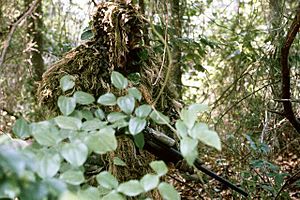Military camouflage facts for kids
Camouflage is a clever way to hide or blend in with your surroundings. It's used by soldiers, hunters, and even animals! Military camouflage uses special patterns and colors on clothing, fabric coverings, and paint to make it super hard to see soldiers, weapons like big artillery guns, and military vehicles. The goal is to make things disappear into the background, whether it's a forest, a desert, or a snowy field.
Contents
What is Camouflage?
Camouflage helps things become less noticeable by matching their color and pattern to the environment. Think of it like a chameleon changing its skin to match a leaf! For armies, this means using colors and shapes that look like trees, rocks, sand, or snow.
Different Types of Camouflage Patterns
Camouflage patterns are designed for specific places.
- In desert areas, patterns use light brown and sandy colors.
- For forests, you'll see different shades of green and brown, like leaves and tree bark.
- In cities, camouflage might use grey, white, and black to blend with buildings and concrete.
- For snowy places, white patterns help soldiers hide in the snow.
Some camouflage patterns are very old, while others are quite new. For example, some modern patterns use tiny squares, called "digital" camouflage, to make them even harder to spot.
History of Camouflage
Camouflage wasn't always used in armies. For a long time, soldiers wore bright, colorful uniforms! But this changed when rifles and cannons became much more accurate in the late 1800s. It became too dangerous to stand out.
- Early Days: Armies started to realize that blending in was important for safety.
- 20th Century: During World War II, camouflage became a very common part of military uniforms. Even planes and trucks were painted with special patterns to hide them from enemies.
Today, almost every country uses its own unique camouflage patterns for its soldiers and vehicles.
Images for kids
-
A-7D Corsairs with a special pattern to break up their shape, Thailand, 1972.
-
A Finnish field gun during the Winter War, hidden with improvised snow camouflage from bedsheets and whitewash.
-
The Canadian Forces were the first to use pixellated digital camouflage called CADPAT.
-
A Swedish Visby class corvette, showing both visual camouflage and stealth design to avoid radar.
-
95th Rifles Regiment reenactors (1802–1816) in their "rifle green" uniform.
-
The Relief of Ladysmith by John Henry Frederick Bacon shows the khaki uniforms used by the British in the Second Boer War.
-
Abbott Thayer's drawings from 1902, showing how to use countershading to hide ships.
-
A British Hawker Hurricane plane with brown and green "temperate land" camouflage.
-
British "dazzle camouflage" from World War I on the ship SS Empress of Russia.
-
A Ukrainian Su-25 plane painted with earth colors on top and sky blue underneath.
-
Edward Wadsworth: Dazzle-ships in dry dock at Liverpool, 1919, National Gallery of Canada, Ottawa, Ontario.
See also
 In Spanish: Camuflaje militar para niños
In Spanish: Camuflaje militar para niños


























